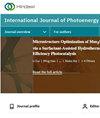升力变流器不同控制策略的比较分析
IF 2.1
4区 工程技术
Q3 CHEMISTRY, PHYSICAL
引用次数: 0
摘要
双输出DC - DC变换器在家用、汽车和工业领域受到广泛关注。双输出变换器通常提供电压降压通道和电压升压通道。通常,一辆汽车需要一个电池充电单元、一个牵引电机驱动器和几个其他应用。一个典型的应用可能需要两个直流输出通道,一个低压(LV)通道和一个高压(HV)通道。虽然文献中有通用升压衍生和二次升压衍生双输出变换器,但本文主要关注升压型罗变换器衍生双输出变换器(LDDOC)的控制方面。太阳能光伏(SPV)源是主要电源,并为电池充电。低压负载可以通过电池连接,并且升降级提供调节的48v输出。通过仿真研究了PI控制器、模糊逻辑控制器、基于神经网络的控制器和滑模控制器(SMC)对48v输出的调节。仿真结果表明,滑模控制器具有满足要求的性能、实现简单、成本低等优点。还建立了一个实验装置来验证滑模控制器在48 V时调节高压通道输出电压的性能。本文章由计算机程序翻译,如有差异,请以英文原文为准。
Comparative Analysis of Different Control Strategies for Relift Luo Converter
Dual-output DC to DC converters have drawn attention in the domestic, automobile, and industrial domains. A dual-output converter usually provides a voltage step-down channel and a voltage step-up channel. Typically, an automobile needs a battery charging unit, a traction motor drive, and several other applications. A typical application may require two channels of DC output with a low-voltage (LV) channel and a high-voltage (HV) channel. While the generic boost-derived and quadratic boost-derived dual-output converters are available in the literature, this article focuses on the control aspects of a relift type Luo converter-derived dual-output converter (LDDOC). A solar photovoltaic (SPV) source is the main power, and it charges a battery. The LV loads may be connected across the battery, and the relift stage delivers a regulated 48 V output. The regulation of the 48 V output using a PI controller, a fuzzy logic controller, an ANN-based controller, and a sliding mode controller (SMC) has been studied using simulations. The simulations reveal that the sliding mode controller is advantageous because of meeting out the required performance, easy implementation, and low cost. An experimental setup has also been developed to verify the performance of the sliding mode controller for the regulation of the HV channel output voltage at 48 V.
求助全文
通过发布文献求助,成功后即可免费获取论文全文。
去求助
来源期刊
CiteScore
6.00
自引率
3.10%
发文量
128
审稿时长
3.6 months
期刊介绍:
International Journal of Photoenergy is a peer-reviewed, open access journal that publishes original research articles as well as review articles in all areas of photoenergy. The journal consolidates research activities in photochemistry and solar energy utilization into a single and unique forum for discussing and sharing knowledge.
The journal covers the following topics and applications:
- Photocatalysis
- Photostability and Toxicity of Drugs and UV-Photoprotection
- Solar Energy
- Artificial Light Harvesting Systems
- Photomedicine
- Photo Nanosystems
- Nano Tools for Solar Energy and Photochemistry
- Solar Chemistry
- Photochromism
- Organic Light-Emitting Diodes
- PV Systems
- Nano Structured Solar Cells

 求助内容:
求助内容: 应助结果提醒方式:
应助结果提醒方式:


